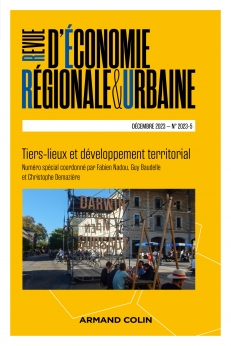
REVUE D'ÉCONOMIE RÉGIONALE ET URBAINE (5/2023)
Pour acheter ce numéro, contactez-nous
Recevez les numéros de l'année en cours et accédez à l'intégralité des articles en ligne.
La diffusion géographique des espaces de coworking (ECW) soulève la question des apports possibles de ces nouveaux lieux à des espaces non métropolitains. Les ECW sont-ils en mesure de contribuer à la résilience architecturale, économique et sociale des territoires « périphériques » ? Quels rôles les différents acteurs du coworking – créateurs-managers, usagers et collectivités territoriales – jouent-ils dans cette possible revitalisation ? Notre hypothèse est que l’apparition de ces nouveaux lieux peut contribuer à la revitalisation des territoires hors-métropoles, mais que parallèlement cette contribution reste marginale et proportionnelle à la taille et l’ancienneté de l’ECW. Trois pistes de cette revitalisation sont pointées : la réhabilitation des bâtiments et friches, la contribution au développement du tissu économique local et enfin les liens sociaux et communautaires engendrés par la présence d’un ECW.
The spatial diffusion of coworking spaces (CWs) raises the question of the possible contributions of these new places to non-metropolitan cities. In the same time, the urban effects and relationship between ECWand urban planning are little studied in the scientific literature. The aim of this article is to move beyond the imaginary worlds created by the new workspaces to look at territorial dynamics. Are CWs able to contribute to the architectural, economic and social resilience of intermediate or peripheral territories? What roles do the different actors of coworking – creators-managers, users and local authorities – play in this possible urban revitalization? Our research hypothesis is that the emergence of these new places can contribute to the revitalization of territories (cities and neighbourhoods...) outside the metropolis in three main ways, but that at the same time this contribution remains marginal and proportional to the size and age of the CWs. Based on case studies mainly from the Centre-Val de Loire region, we try to understand the role and possible transformative effects of CWs as new urban objects. Three approaches for this revitalization are explored : rehabilitation of buildings and brownfields ; contribution to the development of the local economic environment and finally the social and community links generated by the presence of a CWs. In terms of brownfield redevelopment, the size of the agglomeration has an impact on the management of the project. In addition, the economic and community links between the ECW and the surrounding area take forms that contribute directly to the renewal and development of the area. Research findings could make it possible to include the medium-time factor in order to analyse how the founders and managers of the ECWproject themselves onto the area, and how dialogue with the urban authorities is established.